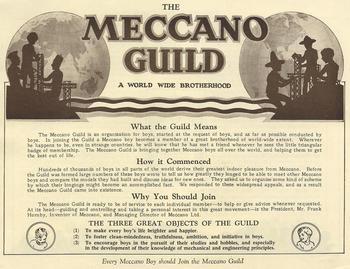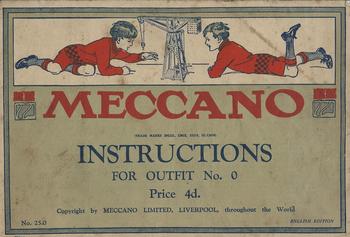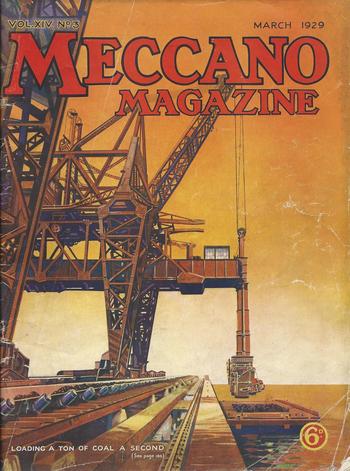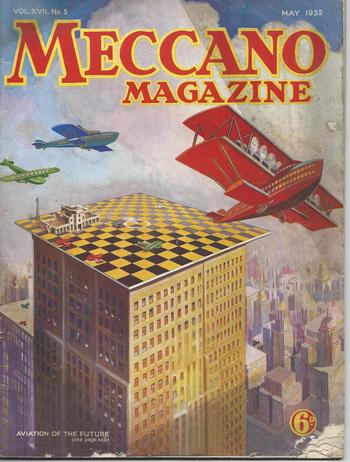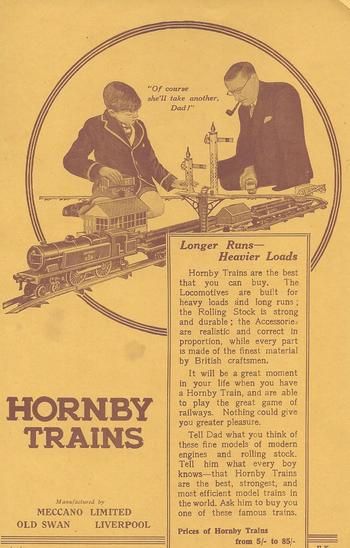‘Meccano’ was the name given to a construction set invented by Frank Hornby at the beginning of the twentieth century. It allowed boys to make models of a wide range of mechanical devices from metal plates and bars bolted together. It became very popular, along with the Hornby model trains and Dinky toy cars introduced later by the same firm. The author of the present article played with all three as a boy in the 1950s, although this was probably the last decade in which the toys were really successful. Meccano Magazine was introduced originally to promote the toys, but when Ellison Hawks – author of a series of juvenile books on popular science – took over as editor in 1921, he decided to turn it into a general boys’ magazine on technology and related subjects. The magazine was immensely successful, eventually reaching a readership of seventy thousand per month. By exploiting Meccano's commercial interests and the natural interests of boys in the latest technologies, Hawks was thus able to create a juvenile equivalent of adult magazines such as Armchair Science. Indeed, Meccano Magazine seems to have been more successful than its adult counterparts in creating a forum for the dissemination of information about developments in technology and, to a lesser extent, the natural sciences.
This paper explores the history of the Meccano firm and its magazine, focusing on Hawks's editorship and the way in which he balanced material on the models (which was the firm's primary reason for supporting the publication) and his wider project to create a popular-science magazine for boys. We shall see that the ideology promoted was both gender-biased and imperialist. The focus on boys rather than girls was quite explicit, paralleling a general assumption prevalent at the time that only boys were sufficiently interested in technology to benefit from information about the topic. It was taken for granted that the boys who read the magazine came from a reasonably well-to-do background, since the toys themselves were quite expensive. The magazine also promoted a strong link between technological progress and the future of the British Empire.
The survey presented here provides an analysis of the content of those parts of the magazine dealing with real-world developments – although these, of course, were often related to the toys the firm produced. The conclusion places the magazine in the wider context of British popular-science literature of the period.Footnote 1 It will be shown that there was considerable overlap between its contents and those of contemporary magazines aimed at an adult readership. The material was also presented in a similar manner to that adopted by the adult magazines and assumed a similar level of background and comprehension on the part of its younger readers. By aiming at a self-selected readership of older boys from well-off families, well educated and with a prior interest in technology thanks to their interest in the models, Hawks could present his material on the real world at a level of sophistication almost equivalent to that required for less-dedicated adult readers. There was little to be gained by oversimplification or other techniques that might be needed to make stories about science and technology suitable for children. This raises the possibility that the popularity of Meccano Magazine may explain why the adult equivalents were never able to achieve the same level of circulation – fathers were reading the magazine they bought for their sons.
Meccano toys
Frank Hornby patented his toy construction set under the name ‘Mechanics made Easy’ in 1901 and renamed it ‘Meccano’ in 1907.Footnote 2 He established a factory in Liverpool to manufacture the sets and by the time of the Great War they had become hugely successful. The sets came in various sizes and prices, but all consisted of metal plates and bars that could be bolted together, along with rods to serve as axles, and wheels. Plans were supplied to show how to construct models of more or less any building or mechanical device, from bridges to aeroplanes. Boys were also encouraged to create their own designs, and one function of Meccano Magazine was to publish photographs and plans of models submitted by readers. A nationwide club, the Meccano Guild, was established in 1919 to encourage boys to set up groups in their local area where they could meet to exhibit their work and to interact with other groups and the firm's headquarters. The magazine would routinely report on the activities of these local groups and also held competitions with prizes for the best designs.
In 1920 the firm introduced Hornby model trains, originally clockwork models in O gauge but in 1938 adding the smaller OO gauge. Electric motors were eventually introduced and from 1949 most of the sets were OO gauge powered by electricity. Substantial train sets were sold, including engines, rolling stock, track and lineside structures such as stations and signal boxes. In 1934 the firm added a new line, Dinky toys, which included metal models of cars, trucks, military vehicles and eventually even ships and aircraft. All three products remained successful through into the 1950s, although there were restrictions on production during the Second World War and the subsequent years of austerity. Only in the 1960s did the firm's fortunes begin to decline as rival products became available and fashions in children's playtime activities changed.
Meccano sets were distributed throughout the British Empire (later Commonwealth) and Meccano clubs were founded in Australia, Canada, India, New Zealand, Nigeria, Singapore and South Africa. At one point the magazine reported that the club in Auckland, New Zealand, was the largest in the world.Footnote 3 News of the empire clubs was frequently reported in the British magazine and readers from these countries were recorded as winning competitions from time to time. Frank Hornby was also anxious to sell on the world market and factories were set up in America and France. The American firm was soon absorbed by the rival Erector firm, but the French products were extremely successful and Hornby trains manufactured models of French engines and rolling stock to satisfy this market. Independent versions of Meccano Magazine were published in both America and France. For this reason the British editions seldom referred to activities in these countries and their magazines are not included in the analysis reported here. Meccano sets were also manufactured under license in Germany and thus became available quite widely in continental Europe. The British magazine did seek to incorporate readers from this market and reported news from clubs in Denmark, Norway and Italy. It also reported prizewinners from Belgium, Holland and Switzerland. There were very occasional winners reported from further afield, including Argentina, Egypt, Malta, Mauritius and Turkey.
Meccano Magazine and Ellison Hawks
Meccano launched its magazine with the September–October issue of 1916.Footnote 4 It was a short pamphlet devoted solely to material relating to the construction set, poorly printed on cheap paper due to wartime restrictions. It expanded in size in 1920 and became monthly in September 1922. By this time Ellison Hawks, the firm's advertising manager, had been appointed editor. Hawks was already a prolific writer of books on science and technology aimed at juvenile readers. He was a fellow of the Zoological Society and of the Royal Astronomical Society and could thus claim some level of expertise in these areas, but he clearly had immense enthusiasm for technology too, hence his connection with the Meccano firm. He had already made a name for himself writing children's books on astronomy and natural history when he was appointed editor of the Romance of Reality book series by the publisher Nelson in 1914. This included books on science and technology by a number of authors and was aimed partly at a teenage readership. Hawks himself provided books on astronomy and radio.Footnote 5 Hawks continued to write books on a wide range of scientific and technical topics for other publishers both during and after his spell as editor of the magazine.Footnote 6

Figure 1. Advertisement encouraging children to join the Meccano Guild. Source: author's collection.
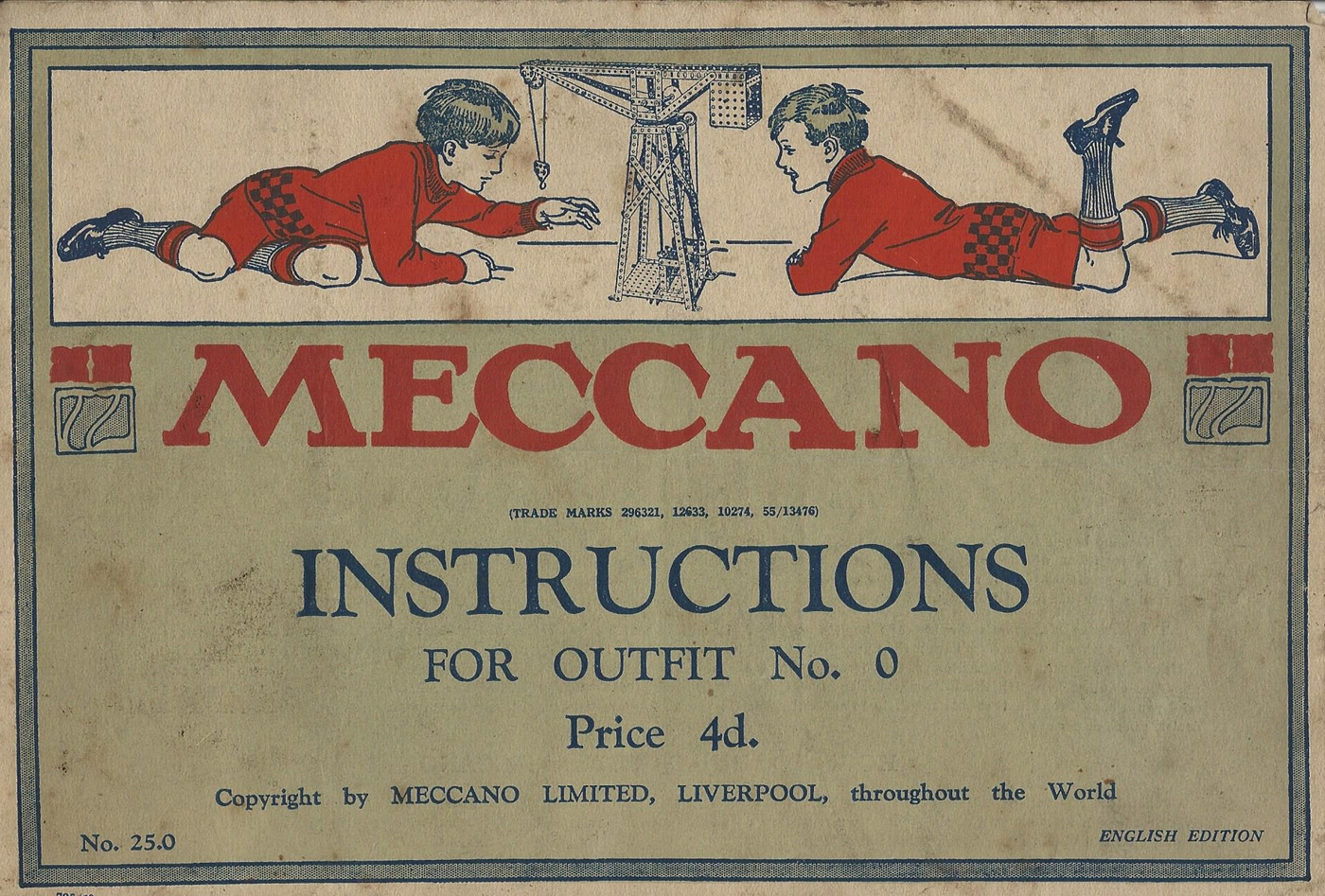
Figure 2. Cover of instruction booklet for Meccano construction set. Source: author's collection.
From the start of his editorship Hawks had ambitions to expand the magazine's content far beyond that of simply promoting Meccano toys. Indeed, he overreached himself almost immediately by proposing to abolish material on the toys completely, but when he invited responses from his juvenile readers they wrote in demanding that it be maintained. A compromise was reached whereby approximately 50 per cent of the content was devoted to the models and the other 50 to real-world developments in technology and science. On this basis Hawks proclaimed in an editorial in November 1923 that he had set out to make the magazine ‘the best and brightest paper for boys’ – and had succeeded.Footnote 7
The claim that the magazine would appeal to boys highlights the gender bias in Hawks's vision of its purpose. It was taken for granted that only boys would be interested in the models that Meccano offered and that this would be reflected in what they wanted to learn about real-world topics. A flyer promoting the Meccano Guild – an organization founded to link the local model-building clubs that were being set up around the country – was quite explicit about the expected membership: ‘The Meccano Guild is an organization for boys, started by boys at the request of boys and as far as possible conducted by boys’.Footnote 8 Photographs of club members published in the magazine during the interwar years show only boys, although girls are occasionally visible as spectators viewing layouts of Hornby trains. The earliest photograph of a girl linked to Meccano itself that I have noticed is in 1940, as a winner in a model-building competition.Footnote 9 The assumption that toys linked to science and technology were appropriate for boys rather than girls was widespread at the time, although there were notable exceptions. Melanie Keene notes that the rival Construments sets (with which Hawks himself was associated) were presented as suitable for both girls and boys.Footnote 10
The boys targeted in Hawks's campaign and in Meccano's wider advertising were necessarily from reasonably prosperous families, since the toys themselves were quite expensive. The magazine itself sold for sixpence, approximately the same as equivalent adult publications (Armchair Science began in 1929 at sevenpence, subsequently rose to one shilling and then dropped to sixpence). Technology was promoted as a major factor both in national prosperity and for the protection and expansion of the British Empire – Meccano clubs were founded around the empire and their activities reported in the magazine. Articles on topics such as transport often noted their relevance for imperial prosperity.
Hawks's aim to make Meccano Magazine a success by appealing to boys’ wider interests in technology seems to have worked. From December 1923 the magazine's presentation was improved with a full-colour front cover and from this point onward the covers became one of its most distinctive and attractive features (they are still eagerly sought collectors’ items). The image invariably related to one of the real-world topics covered in the issue, not to the models. The combination of promotional material on the toys (including later on Hornby trains and Dinky toys) with well-written and easily accessible material on the latest developments in science, technology and world exploration, all packaged in an attractive cover, was immensely successful. By the late 1930s circulation had reached seventy thousand copies per month, far outstripping that of adult popular-science magazines such as Discovery and Armchair Science.
Hawks stepped down as editor in 1935 and was replaced by his former assistant, W.H. McCormick, who continued the by now well-established format. In 1942 wartime restrictions forced a reduction in size and quality, and although things improved in the 1950s circulation had dropped to forty thousand. Covers were now based on photographs rather than artists’ drawings, but the illustrations within were of poor quality. In June 1960 a questionnaire was included seeking readers’ interests and requests, and in response the size of the magazine was increased from January 1961. But by 1962 the magazine was running at a loss and Meccano sold it to a commercial publisher, Thomas Skinner. The format was changed and publication continued until 1981, although by this time the magazine was a pale shadow of its former glory.
Contents of the magazine
By the mid-1920s the format established by Hawks had stabilized with approximately half the material devoted to Meccano products. The rest dealt with real-life developments in technology and, to a lesser extent, pure science, but also a substantial proportion of articles on geography and exploration. There was also some history, especially focused on the history of science and industry. Most of the articles were unsigned and were almost certainly written by Hawks himself. After he resigned, the same format persisted but with a much greater proportion of the articles written by professional writers familiar with the technical issues they described.
The material devoted to Meccano toys usually came toward the end of each issue. It included announcements of new products, plans for construction and model railway layouts, competitions, news from readers and announcements concerning the Meccano Guild. There was also a regular column devoted to stamp collecting, another popular boys’ hobby. This no doubt encouraged a broader readership, but since the stamps described came from a wide variety of countries it also served as a link to the articles dealing with world geography.
The first half of each issue was devoted to real-world issues, although sometimes there would be a link to the toys section if it was possible to construct a model of a technological device being described. A number of regular features appeared every month. The issue always began with Hawks's ‘With the editor’ page, in which he provided short news items often linked to the latest developments in science and engineering. Sections ‘Of general interest’ and ‘Our wonderful world’ also provided news items, while ‘Books to read’ included reviews of the latest books for juvenile readers. As with the editor's column, these sections frequently relayed news about developments in pure as well as applied science and engineering. Not surprisingly, Hawks's own productions were regularly reported in ‘Books to read’. A section entitled ‘From our readers’ printed letters describing the activities and interests of boys, especially if they lived or travelled abroad. A more light-hearted section, ‘Fireside fun’ relayed jokes and humorous stories.
Three regular features were directly concerned with technologies that provided the basis for Meccano models, Hornby trains or Dinky toys. These were ‘Engineering news’, ‘Railway news’ and ‘Air news’. They provided information on the latest developments in engineering and transport from around the world, although there was a strong focus on British achievements. In the interwar years it is notable that there was relatively little emphasis on military technology. The ‘Air news’ column did occasionally report on military aircraft and a new fighter featured on the front cover of the March 1931 issue, but the vast majority of the coverage was devoted to civilian aviation. This supports David Edgerton's claim that deliberate efforts were made to deflect attention from military developments during this period.Footnote 11 Not surprisingly, there was significantly more coverage of military technology in the war years, with front covers and related news occasionally featuring tanks, naval ships and military aircraft.
In addition to the regular columns on specific topics the magazine frequently published series of articles on a single theme which continued over a number of issues. Again, many of these featured topics in technology and industry. They included ‘Lives of famous inventors’ (intermittently from 1923 to 1931), ‘Electricity’ (1925), ‘Famous bridges’ (1925), ‘The story of metals’ (1925), ‘The story of coal’ (1927) and ‘The romance of whaling’ (1932). Geography featured in a series on ‘Exploring the Arctic’ (1927) and ‘Exploring the Antarctic’ (1931). There were also occasional series on purely scientific topics. ‘The story of prehistoric man’ (1933) provided descriptions of the well-known fossil hominids such as Neanderthals, while indirectly raising the still controversial topic of human evolution. In 1935, the year Hawks stepped down, Walter S. Adams of the Mount Wilson Observatory contributed a series on ‘The planets and their atmospheres’.
Space forbids a complete listing of all the topics covered in the decades over which the magazine was published. Paralleling the long-running series listed above, a substantial proportion of the individual articles dealt with technology and engineering. But there was also significant coverage of some areas of science and of geographical issues. Examples from the 1930s include ‘How wireless waves curve around the Earth’, explaining the Heaviside layer, ‘What chemists do’ and ‘Exploring the solar system’, which dealt with the discovery of the planet Uranus. In the area of natural history there was ‘Plants that feed on insects’; ‘Man fights insect enemies’; ‘The cats of Rancho La Brea’, dealing with the extinct animals found in the tar pits there; ‘Marvels of bird migration’; and ‘The hedgehog and its ways’.Footnote 12
Geographical topics were well represented, with many articles describing the customs and lifestyles of peoples around the world. Oceanography featured in ‘Vast deeps in the great ocean’. Physical geography appeared in articles such as ‘Sand rivers of the Zambesi Valley’. Anthropological reports included ‘A night in an Eskimo igloo’, ‘Self-torture of Hindu fakirs’ and ‘The Maoris of New Zealand’. There was also occasional coverage of historical and archaeological investigations, such as ‘The Wailing Wall at Jerusalem’ and ‘Ancient tombs of Central America’.Footnote 13
A more detailed picture can be obtained by surveying a single issue. That of June 1927 was of particular interest to Hawks because there was a total eclipse of the sun due to occur on the twenty-ninth of the month. He referred to it as ‘This month's great event’ in his editorial column and included a substantial article later in the issue explaining what happened in an eclipse and how to view it safely, and describing the events of the 1919 eclipse when Arthur Eddington obtained results confirming Einstein's theory of relativity.Footnote 14 An ‘Eclipse competition’ was announced, inviting boys to send in photographs or sketches of the event. There were contributions to the ‘Exploring the Arctic’, ‘The story of coal’ and ‘Lives of famous inventors’ series, the latter dealing with James Watt.
The regular ‘Our wonderful world’ and ‘Of general interest’ columns provided information on scientific topics. ‘Our wonderful world’ described Irving Langmuir's work on splitting the hydrogen molecule, noting that the recombination of the atoms generated intense heat that promised to be of use for welding metals. Astronomy was included with a short note on the depth of the atmosphere on Mars. Palaeontology was represented by two notes, one on dinosaur fossils from Africa (which recorded speculations that the ancient reptiles might still be alive deep in the jungles) and the misidentification of an elephant tooth from Java, originally described as belonging to the fossil hominid Pithecanthropus. ‘Of general interest’ reported the discovery of a new star by an astronomer at Harvard University and an explosion at a liquid-air plant. The use of searchlights to project images on clouds was reported. Natural history was covered by two notes on fishes that can change their colour and on native British carnivores such as stoats and foxes.
In the area of technology there were several articles dealing with transport. For railway enthusiasts there was news of the latest Director class of locomotives for the London and North Eastern Railway. Other articles described the duties of a railway signalman and the continued use of horses in railway goods yards. Foreign railway news included the building of a new line through the Khyber Pass. Shipping was well represented with articles on express ferries to the Hook of Holland, the training of crews for ocean liners, and a new design of motor lifeboats. This issue had unusually little on aviation, the only article in addition to the regular ‘Air news’ being devoted to learning to fly. Motoring was covered by a description of a new form of gearbox and an account of how Ford's assembly lines in America had produced large numbers of tractors during the Great War. Modern communications were covered in an account of a visit to a Post Office telephone exchange.
Two unusual features looked both to the past and to the future. History appeared in the form of an article describing the use of the stocks as a punishment in olden times. The future was addressed in a science fiction story by B.J. Bowyer describing a war between Earth and Mars in the year 4000 AD.Footnote 15 Bowyer predicted life with ‘all electric comforts’ and travel by helicopters at two hundred miles per hour. The Martians invade Earth because humanity is making too much radio noise. They use aerial ships armed with death rays, while humanity fights back with improved guns. Eventually a peace treaty between the two planets is signed. Meccano Magazine did not normally include fiction, so it is of some interest to find this adventure story aimed at boys and including futuristic technologies that were becoming the stock-in-trade of science fiction stories aimed at adults.
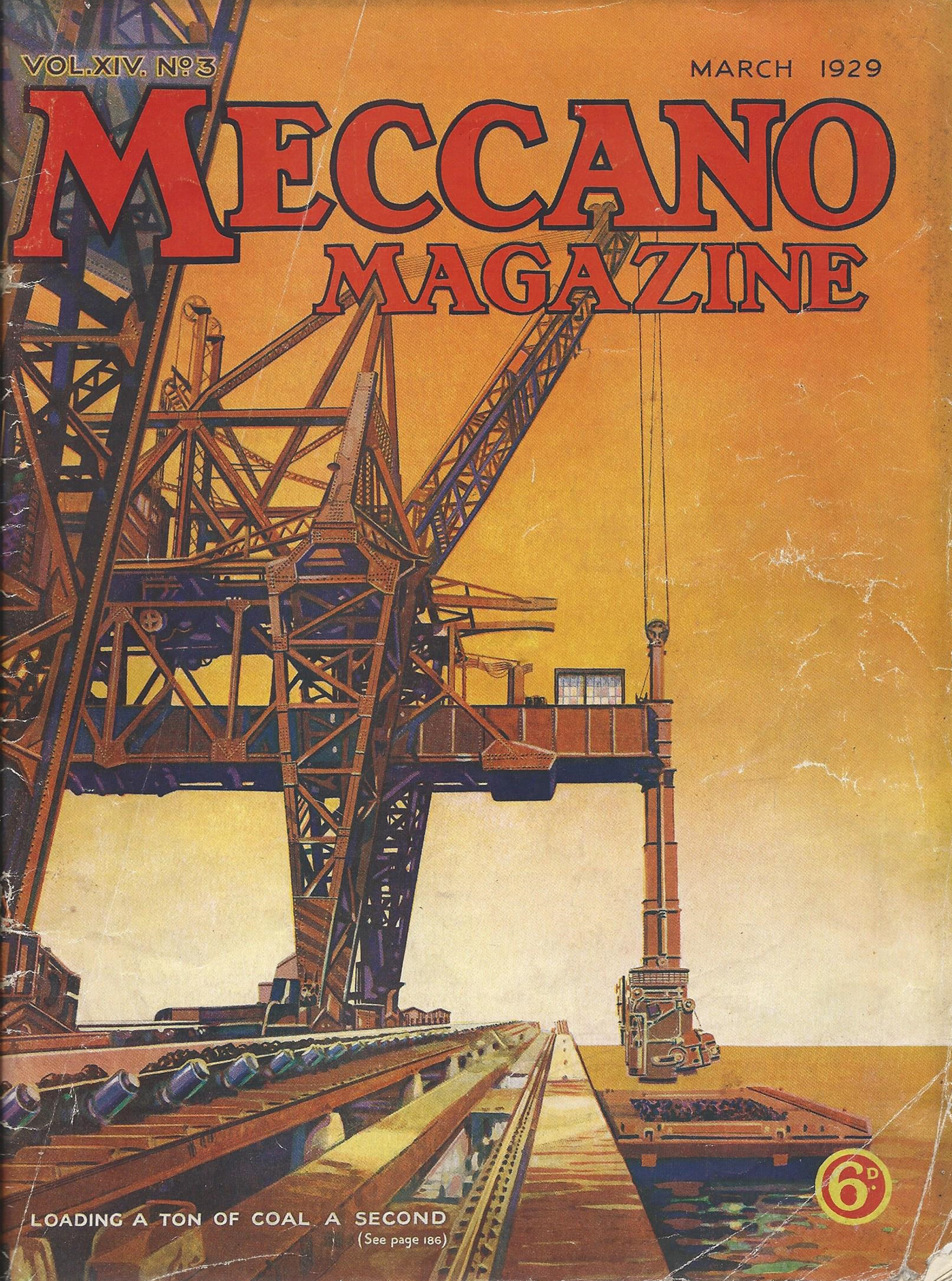
Figure 3. Cover of Meccano Magazine for March 1929 showing crane for loading coal onto shipping. Source: author's collection.
The science fiction story was certainly unusual, but the magazine did sometimes provide news of projected future developments in technology. The September 1930 issue reprinted a lecture given by J. Clayton on the future development of railway locomotives.Footnote 16 The May 1932 issue had a cover illustration showing a futuristic airport on the roof of a skyscraper, linked to an article on ‘Aviation of the future’. This described a number of potential developments, favouring aeroplanes over airships and commenting on new methods of propulsion. Helicopters were also seen as a realistic development for everyday travel.Footnote 17 The ‘Air news’ column in October of the same year included an illustration of a proposed twin-bodied transatlantic airliner.
The austerities of the war years and after forced the magazine to cut down both its size and the quality of the paper and printing. Things began to improve in the 1950s, by which time the cover illustrations were based on photographs rather than artists’ paintings. The pre-war balance between material on toys and on the real world was maintained, with if anything a slight preponderance of the latter. But there was now very little on the natural sciences – the focus was strongly on technology and engineering. Most of the regular monthly features were retained, but the ‘Of general interest’ section (which had contained much of the information on pure science in the pre-war years) appeared only infrequently, and it too was dominated by technology. A new regular column was introduced under the title ‘Road and track’, dealing with motoring and motor racing. A small amount of material was retained on geographical topics. In 1960 there was an account of a proposed scheme to import reindeer into Canada so that the Eskimos could be trained to herd them as in their native Lapland.Footnote 18 The December issues often contained historical material linked to the theme of Christmas.
An important development in this period was the inclusion of a fairly regular column entitled ‘Space notes’, written by J. Humphreys. This included news of the latest developments in rockets and space exploration, with frequent references to plans for future propulsion systems and missions to the Moon and planets. There were descriptions of solar-powered ‘sails’, ion rockets and a magnetic pinch plasma engine, and an account of an eight-man expedition to Mars being planned by the Boeing company. The ‘Air news’ column in 1960 included accounts of experiments being made in America to develop atomic-powered aircraft and a vertical take-off jet being designed by Boulton Paul in Britain. On the ground, there was a prediction that the monorail trains being used at Disneyland in California might represent the future for urban transport.Footnote 19 Despite these efforts to promote the future benefits of technological development and an increase in size in 1961, the magazine was now in difficulties and as noted above it was sold by Meccano in 1962. The later years through to its demise in 1981 are not discussed here.
Meccano Magazine as popular science
For Frank Hornby and the Meccano company, the main purpose of the magazine was to promote their toys and encourage sales. Hawks realized that one way of doing this was to exploit boys’ enthusiasm for their models by telling them about the real-world machines and devices they were modelling. But he was also anxious to extend the magazine's remit to include a wider range of information about the underlying principles of applied science, coupled with associated topics such as stargazing, natural history and geographical exploration. It was suggested earlier that he thereby turned Meccano Magazine into a juvenile equivalent of the adult popular-science magazines of the period. This concluding section will justify that claim by comparing the magazine's content with that of three adult periodicals, Discovery, Conquest and Armchair Science.

Figure 4. Cover of Meccano Magazine for May 1932 showing imaginary airport on roof of skyscraper. Source: author's collection.
A possible objection to the claim would be to point out that most of the non-toy content was focused on technology, with little effort being made to explore the detailed science of the underlying processes. It was thus a popular-technology, not a popular-science, magazine. This objection would certainly have some validity for the period after the Second World War, when technology and engineering proliferated to an extent that almost eliminated anything else. But it is certainly not valid for the period of Hawks's editorship and the later 1930s. During this period there was significant coverage of topics in the natural as well as the applied sciences. Furthermore, the assumption that we can establish a clear distinction between the pure and applied sciences would be quite anachronistic, as can be demonstrated from the contents of the adult magazines that were explicitly presenting themselves as offering easily accessible accounts of developments in both science and technology for the ordinary reader. There were three such magazines published in interwar Britain: Discovery, Conquest and Armchair Science.
All of these magazines moved seamlessly across a spectrum of topics ranging from pure to applied sciences, technology and engineering. The same is true for publishers’ book series such as the Romance of Reality series that Hawks himself edited. Commercial publishers realized that most public interest in science was centred on its practical applications. But to have even a basic understanding of new technologies such as X-rays or radio one needed at least a smattering of knowledge of the underlying physics, in this case of electromagnetic radiation. It was difficult to get the technical principles of scientific theories across to the ordinary reader, but efforts were certainly being made, more especially in the books published during this period. Moreover, in addition to practical applications there were popular hobbies that intersected with areas of ‘pure’ science. Many people had a casual interest in stargazing, and some became accomplished amateur astronomers with their own telescopes and so on. They wanted information about the stars and planets, but might also be interested in the latest cosmological theories. There was also huge popular interest in natural history, and here information on new discoveries in botany and zoology would be relevant, perhaps even raising deeper questions about classification, evolution and ecology.
Hawks was by no means the only author with some level of technical expertise who wrote prolifically across this wide range of topics. Charles R. Gibson wrote over twenty books in an equally broad range of scientific and technical areas, mostly aimed at teenage readers. The magazines, too, presented themselves as providing information on the whole spectrum of scientific and technical fields. Discovery was founded by an elite group of scientists and academics in 1920 to provide information on a wide range of new research topics including science, geographical exploration and archaeology. Founded a year earlier, Conquest aimed to supply news of the ‘conquests’ of the natural world by science and was renamed Modern Science just before it closed down in 1926. This was a commercial publication issued by the Wireless Press which specialized in books for radio enthusiasts, so not surprisingly it had a strong focus on applied science. Armchair Science, which ran from 1929 to 1939, had a publishing team with a similar background in the applied physical sciences. Unlike Discovery, which was soon being published at a loss by John Murray, Conquest and Armchair Science were expected to make a profit and had to monitor their readers’ interests in order to maintain a viable circulation.Footnote 20
Because of their different backgrounds, the three adult magazines differed in their coverage of science and related topics, but a detailed comparison with the relevant sections of Meccano Magazine shows that the latter fits in very well with the image of what counted as ‘popular science’ for the general public. The most obvious point to note is that the strong focus on applied science, technology and engineering was shared with the two commercial publications, Conquest and Armchair Science. Since they were published and edited by people with a strong interest in these areas, their vision of what the public wanted from science – applications of value in their everyday lives – exactly matched Meccano's links with technology and engineering. Both magazines devoted around half of their specialist articles to applied science (there would also be additional material in general news items). Even the prevalence of articles on transport shows a parallel – the adult magazines, too, had frequent articles on trains, shipping and aviation. Armchair Science eventually ran a monthly column on motoring. It also had regular features on the history of technology, again paralleling Meccano Magazine. There were differences, however, since the adult magazines included numerous articles on inventions that were expected to be useful in the household, an area in which the juvenile readers of Meccano Magazine would have had little interest. Hawks's policy of aiming his magazine exclusively at boys ensured that topics assumed to be of interest only to girls were excluded. By contrast, A.M. Low, science adviser and later editor of Armchair Science, made a conscious effort to attract women readers.
Meccano Magazine carried very little material on the major developments in theoretical science taking place at the time. But neither did the adult magazines. Although Conquest responded to the public excitement generated by the 1919 eclipse expedition that confirmed Einstein's theory of relativity, it had very little on theoretical physics or chemistry thereafter. Armchair Science similarly ignored the huge advances being made in nuclear physics and related areas. Both had less than 5 per cent of their content in this area. Even Discovery – which might have been expected to proclaim the latest theoretical developments – published only occasional pieces on the most important advances such as the discovery of the neutron. The same is true for developments in biology such as the emerging synthesis of evolution theory and genetics, which was also ignored except for a few articles in Discovery. The content of all three magazines thus did not reflect adequately what modern historians regard as the major theoretical innovations of the period. There seems to have been an assumption, shared even by the academic scientists who wrote for Discovery, that such theoretical developments would be either too esoteric for the general public to comprehend or of little general interest. Here again, the content of Meccano Magazine fits the pattern established by the adult publications.
Meccano Magazine did provide limited but significant coverage of astronomy and natural history. These were areas of interest to many adults, and it was widely assumed that children, too, would be interested especially in nature study. Not surprisingly, the adult magazines also saw the potential importance of attracting readers whose hobbies lay in these areas. Conquest ran a monthly column aimed at amateur astronomers in most years, and even Discovery followed suit occasionally – especially in the years following the closure of its rival (whose readers had been advised to move their subscriptions to the surviving publication). Curiously, Armchair Science did not seek to involve the stargazers until the late 1930s when it began to support a club for those interested in the field. It also failed to acknowledge the wide public interest in natural history, a field that both Conquest and Discovery covered in some depth. Conquest ran a regular column on ‘Animals of interest’ in most years, while Armchair Science’s contributions in this area were fewer and more sporadic. Discovery sought to engage with the many amateur naturalists who found that they could contribute to the surveys required by the new science of ecology. Meccano Magazine’s coverage of these two hobbyist areas of science thus had many parallels with its adult counterparts.
The substantial coverage of geographical material in Meccano Magazine also shows similarities with two of the adult periodicals. Discovery explicitly tried to draw comparisons between ‘discoveries’ in science and in other fields such as geographical exploration and archaeology (the latter mostly in relatively exotic parts of the world). The proportion of its articles devoted to these topics was significant from its first year of publication and rose to around 35 per cent in the years around 1930. Given that the magazine also published occasional articles on other non-scientific topics, at this point the sciences seemed almost to be forced into second place. Only when C.P. Snow took over as editor for a new publisher, Cambridge University Press, in 1938 did it become almost exclusively devoted to science. Conquest too spotted this mechanism for attracting public attention and soon included regular articles on geographical topics. Armchair Science also included occasional articles in this area.
In the modern world one of the most important components of non-specialist surveys of scientific advance is the biomedical sciences, along with explanations of how the science is helping medical practice. Given that its readers were mostly boys interested in trains, cars and aircraft, it is not surprising that Meccano Magazine did not publish material in this area. But coverage of this topic in the adult magazines was also very limited by modern standards and appeared only when some discovery had attracted significant attention in general newspapers and magazines. In part this reflects the interests of the publishers – the academics who controlled Discovery were in principle determined to limit the coverage of applied science, while Conquest’s publishers (the Wireless Press) were focused strongly on the applied physical sciences. As a result, the biomedical sciences occupied only around 5 per cent of their overall coverage. Armchair Science came from a similar background, but it did carry rather more material in this area and the proportion increased in the late 1930s. This may reflect growing public hopes that advances in biology would result in improved medical treatments. Nevertheless, the absence of this topic from the contents of Meccano Magazine does not distance it as much as one might expect from its adult counterparts.
Teenagers and adults compared
Although there were some differences between Meccano Magazine and the adult popular-science periodicals there were also many similarities, and the adult magazines did not in any case present a unified model of what should be included within their sphere of action. There are thus valid reasons for arguing that the policy adopted by Hawks for creating a ‘bright’ paper for boys resulted in the publication of what was, in effect, a juvenile popular-science magazine which also promoted models of real-world technologies. Its coverage of science and technology matched in many ways that of the adult magazines, and indeed the physical and literary presentation of the content reveals considerable similarities. Both the type of language used and the frequent illustrations give the adult and the juvenile magazines a very similar ‘feel’. Articles in Meccano Magazine would not have seemed out of place in Conquest or Armchair Science. What was appropriate for a well-educated early teenager with technical interests was probably only just within the reach of most less sophisticated adults. The boys were drawn to the magazine by their interest in model trains and other forms of engineering, and their engagement and enthusiasm more than made up for their youthful inexperience in other areas. Unlike the situation where information on science (or any other topic) is presented to younger children, this self-selected readership of enthusiasts did not need to be addressed via dedicated educational techniques.
Hawks knew the readership he was aiming at – boys who made Meccano models and ran Hornby trains – and his judgement about the level of coverage they would appreciate in articles on real-world technologies was vindicated by the magazine's success. He assumed that their existing interest in and enthusiasm for the subject would enable them to absorb material presented at a level of sophistication very close to that which would be suitable for less well-prepared adults. Nor was this an isolated case of editorial policy – other magazines aimed at the same readership, such as Modern Boy and the Boy's Own Paper, also published quite sophisticated accounts of technological developments. These were clearly juvenile magazines – Meccano Magazine’s material on the models and the adventure stories in Modern Boy and Boy's Own Paper were targeted squarely at boys. Yet when they published on technology they adopted a level of presentation close to that found in adult magazines. The same kind of overlap can be seen in the books of writers such as Hawks and Charles R. Gibson – those aimed at enthusiastic teenage readers would be suitable for any adult who had little previous knowledge of science and technology. When the Science Museum in London opened its Children's Gallery in 1931 it was noted that many adults found the presentations quite appropriate for their own level of engagement.Footnote 21
Advertisements for Meccano and Hornby trains sometimes showed the father playing along with his son. It would not seem improbable that if the fathers bought Meccano Magazine for their sons, they might read the articles on real-life topics for their own information and amusement. This raises the intriguing possibility that the popularity of Meccano Magazine might explain the lack of success enjoyed by the adult periodicals – they were not just equivalents, they were rivals. None of the adult periodicals achieved a circulation anywhere near the seventy thousand per month reported for Meccano Magazine in the 1930s. Although various claims for significant circulation were made by the adult magazines, these were almost certainly exaggerated. After some initial success, Discovery’s circulation dropped to only a few thousand copies a month and it was supported at a loss by the publisher. The other adult magazines certainly made greater effort to find out what the public wanted and to provide it, but they had only limited success. The collapse of Conquest after only six years of publication suggests that it had never gained enough readers to make a profit. Armchair Science was eventually taken over by an American firm and ceased to be a really independent magazine. Compared to science magazines in other countries like America and Germany, the British publications were never able to command enough readers to count as really ‘popular’.Footnote 22
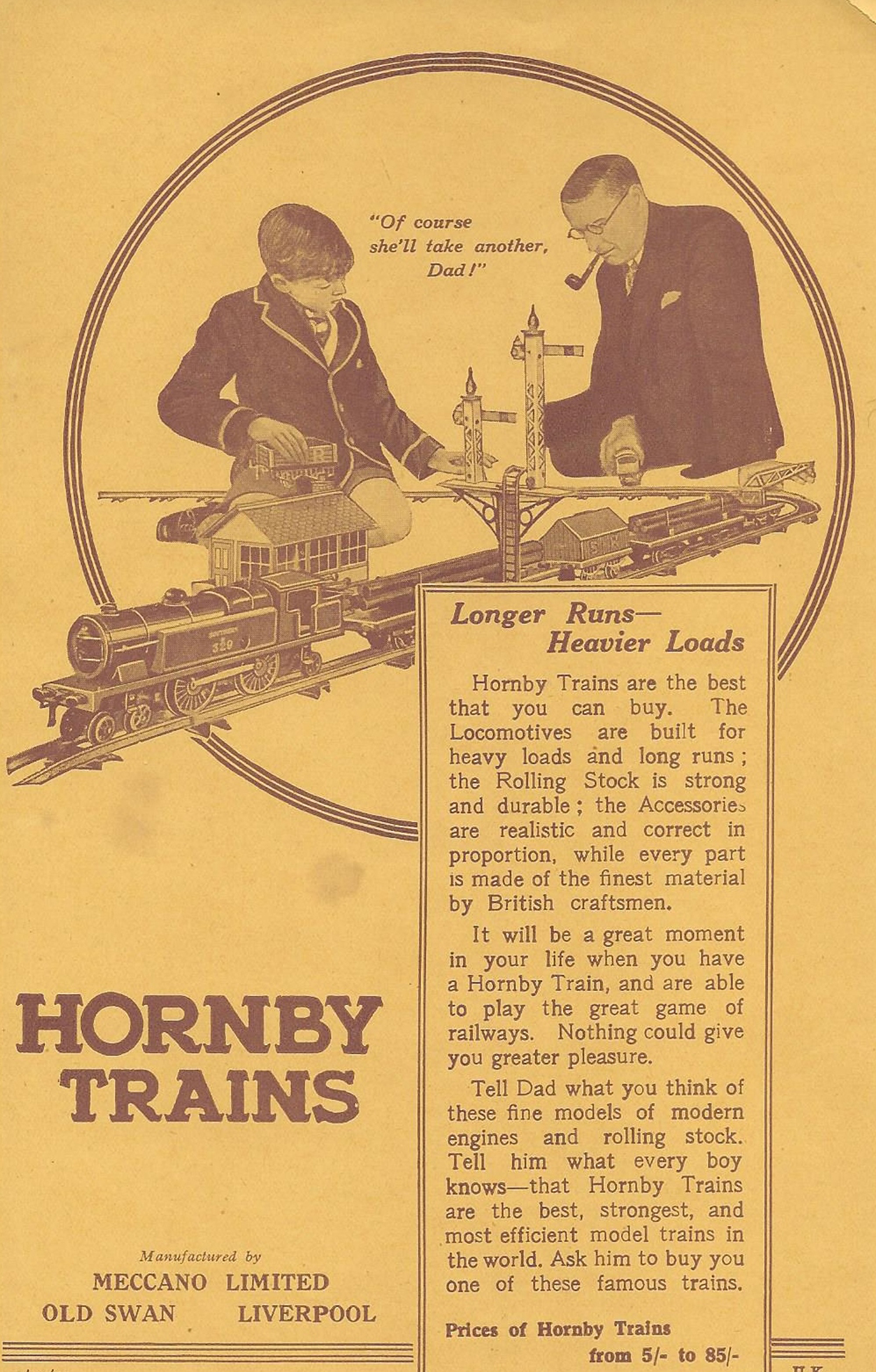
Figure 5. Advertisement for Hornby model trains. Note that fathers are encouraged to play along with their sons. Source: author's collection.
We are thus led to the possibility that a juvenile magazine with very similar content and presentation may have indirectly cornered so much of the adult market that it was impossible for a dedicated adult rival to gain a significant readership. Meccano Magazine included much of the territory covered by the adult science magazines, and its strong focus on technology also paralleled the contents of both Conquest and Armchair Science. The level of discussion was also very similar. The fact that the boys’ magazine devoted half of its contents to model building obviously distanced it from the adult equivalents. But if Meccano's advertising encouraged fathers to engage with their son's activities, they may not have been embarrassed to be seen reading the Meccano Magazine. It would be hard to substantiate the claim that the boys’ magazine damaged the prospects of those aimed at the adult British readership. Given its popularity, however, we may at least speculate that the very limited success achieved by the adult magazines in comparison with some other countries may owe something to Meccano Magazine’s presence in the marketplace.




